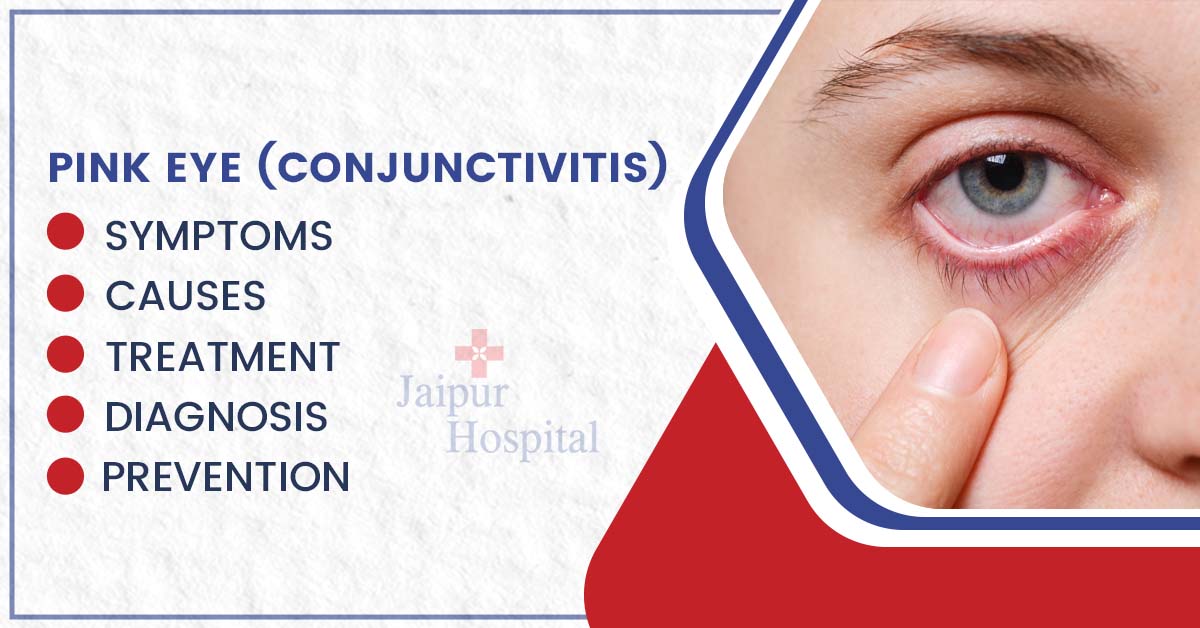Inflammation of the tissues lining the eyelids is a common symptom of pink eye (conjunctiva). It is brought on by irritants, allergens, germs, and viruses like COVID-19, a coronavirus that causes the common cold. Therapy options include eye drops, ointments, tablets, water flushes, and comfort care, depending on the individual reason.
What is conjunctivitis (pink eye)?
The eye’s white area can turn pink or red due to conjunctivitis, sometimes known as “pink eye” or “sticky eye.” Watery, painful, or itchy eyes that occasionally have a yellow or white discharge might affect one or both eyes. Inflammation of the conjunctiva, the clear outer layer of the eye, as well as the interior of the eyelid, causes this. Conjunctivitis caused by allergies may be seasonal or brought on by a particular allergen, such as pollen or animal dander. Both bacterial and viral conjunctivitis can spread quickly, so it’s critical to have the precise cause diagnosed by a physician, optometrist, or pharmacist so that you can receive the appropriate care.
What are the symptoms of conjunctivitis (pink eye)?
The following signs will be noticeable if you have a pink eye infection:
- Symptoms of infection include redness and irritation of the eye
- An overactive tear gland produces a watery discharge
- Eyelashes that are sticky or crusty, especially in the morning
- A feeling of sand in your eye because of soreness in your eye
- Increased swelling caused by inflammation or constant rubbing
- The sensation of burning or itching
- If you wear contact lenses, you will experience constant discomfort
When these signs appear, get prompt medical attention to prevent the infection from spreading to the other eye. Conjunctivitis that is brought on by external irritants like dust typically affects both eyes at once.
You Can Read Also:- Black Teeth: Causes, Symptoms, and Treatment
Other flu-like symptoms that the patient may encounter depending on the infection’s underlying etiology include:
- enlarged lymph nodes
- Fever
- Headache
- Painful limbs
- sore throat
- puffed, swollen, and reddened eyelids
Make sure the youngster receives the necessary medical care as soon as possible if the redness or puffiness of the eyelids is noticeable. By doing so, you can stop the infection from spreading and other problems from developing.
Causes of Conjunctivitis (Pink Eye):
Viruses and bacteria are the most frequent causes of conjunctivitis, although other causes include allergies, ultraviolet light, chemicals, and environmental irritants.
- Viral conjunctivitis. It is brought on by the same viruses that frequently cause the common cold. Common colds frequently accompany viral conjunctivitis. These viruses are extremely infectious (spread easily from person to person), and anyone can spread the infection to their eye by touching it or blowing their nose with their eyes open.
- Bacterial conjunctivitis. Numerous bacterial species are responsible for its occurrence. Additionally contagious, bacterial conjunctivitis typically requires a brief course of antibiotic eye drops or ointment.
- Allergic conjunctivitis. It is non-contagious and typically happens in the spring, summer, and early fall. Exposure to grasses and plant pollen frequently causes it to manifest. People who are allergic to dust mites or animals may experience symptoms all year long.
- Additionally not contagious, chemical conjunctivitis is brought on by contact with irritants such as:
- chlorine in swimming pools
- solutions for contact lenses
- cosmetics
- foreign substances
- the loss of vision
- Bright light can cause snow blindness.
- smoke
- wind
Some medical conditions can cause conjunctivitis in some people. Thyroid disease, gout, specific cancers, some skin conditions like rosacea or psoriasis, tuberculosis, and syphilis are among them.
How is Conjunctivitis (Pink Eye) Diagnosed?
Pink eye can typically be identified by asking about your recent health history, and symptoms, and looking into your eyes.
The fluid that drains from your eye may occasionally be sampled by your healthcare provider and sent to a lab for a procedure called a culture. If your symptoms are severe or if your doctor thinks there may be a high-risk factor, such as:
- A foreign body in your eye.
- Severe bacterial infection
- An infection acquired sexually.
When to See a Doctor?
If you experience any of the following symptoms in addition to conjunctivitis, you should see a doctor:
- discomfort in the eye(s)
- when wiping discharge from the eye(s), the light sensitivity or blurred vision does not get better.
- the eyes are extremely red
- a weakened immune system, such as from HIV infection, cancer treatment, or other medical conditions or treatments, such as symptoms that worsen or do not improve, such as pink eye thought to be caused by bacteria that do not improve after 24 hours of antibiotic use.
Immediately after exhibiting conjunctivitis symptoms, newborns should see a doctor.
Treatment of Conjunctivitis (Pink Eye):
The treatment depends on the cause.
- These viruses, which also cause the common cold, frequently cause this kind of pinkeye. The duration of this type of pinkeye, which typically lasts between 4 and 7 days, must pass just as a cold must. Do everything in your power to stop the spread because it can be extremely contagious. Any virus-related illness won’t improve with antibiotics. Herpes-related pinkeye can be extremely serious and may require prescription antiviral eye drops, ointment, or pills.
- You’ll take antibiotics if bacteria, including those connected to STDs, were the cause of your pinkeye. For five to seven days, you might need to apply eye drops or ointments to the inside of your eyelid three to four times per day. You might be prescribed an oral antibiotic for more difficult infections or for uncommon cases of pinkeye brought on by gonorrhea or chlamydia. For several days, you’d take pills. Within a week, the infection ought to get better. Even after the symptoms disappear, follow your doctor’s instructions for using the medication.
- If you have pinkeye brought on by an annoyance, rinse your eyes with water for five minutes. Within the next four hours, your eyes should start to get better. Call your doctor right away and immediately rinse your eyes with plenty of water if you believe that bleach or another acidic or alkaline substance is to blame for your conjunctivitis.
- After receiving treatment for your allergy and avoiding your allergy trigger, conjunctivitis caused by allergies should get better. In the interim, antihistamines (oral or in the form of drops) can provide comfort. But, keep in mind that if you already have dry eyes, taking antihistamines orally could make them even worse. If you believe an allergy is the cause of your pinkeye, consult a doctor.
How can Conjunctivitis (Pink Eye) be prevented?
Pink eye can spread quickly, but by taking these easy steps, you can greatly lower your risk of developing conjunctivitis or passing it on to someone else.
- Use warm water, and soap and at least 20 seconds to thoroughly wash your hands.
- Use an alcohol-based hand sanitizer that contains at least 60% alcohol to clean your hands if you don’t have access to soap and water or soap and water.
- You shouldn’t use your hands to touch or rub your eyes.
- Use a clean, damp washcloth to wipe away any discharge from the area around your eye(s) several times each day.
- Never exchange towels or washcloths.
- Wash towels, sheets, washcloths, and pillowcases frequently in hot water with detergent.
- Any eye and face makeup or cosmetic brushes you used while infected should be thrown away and replaced.
- If you wear disposable contacts while your eyes were infected, throw away the cases as well.


